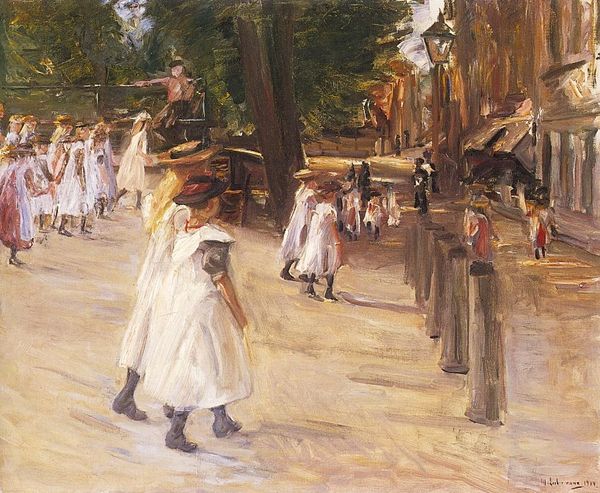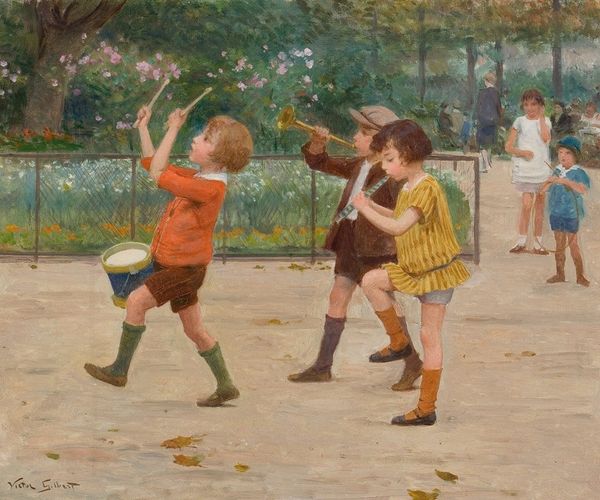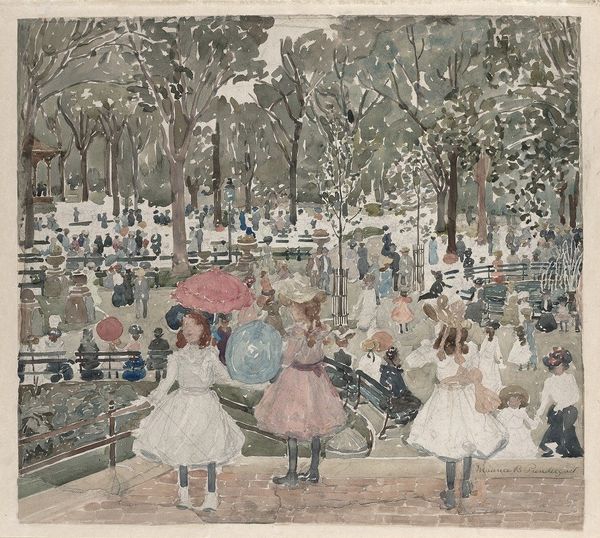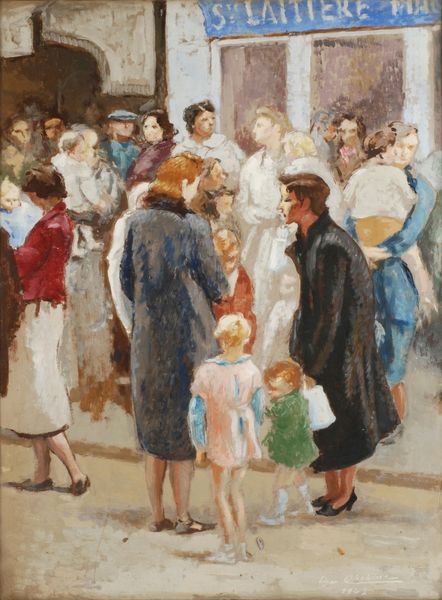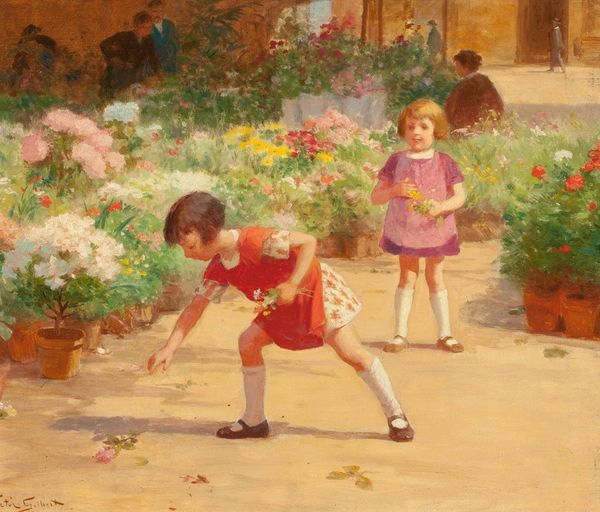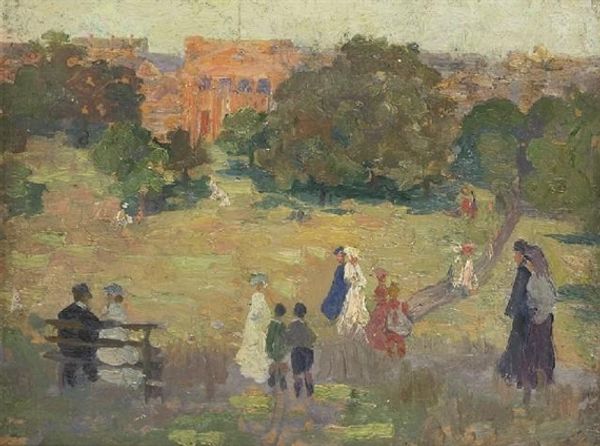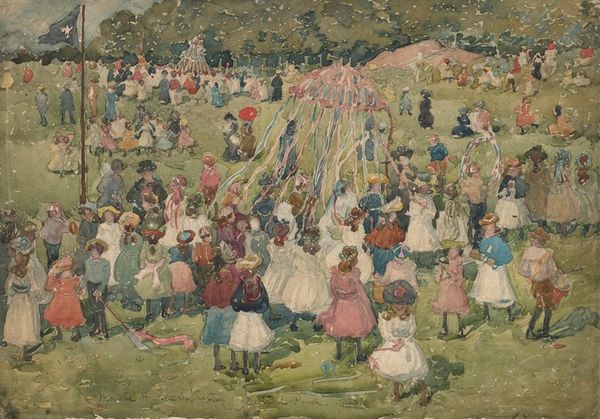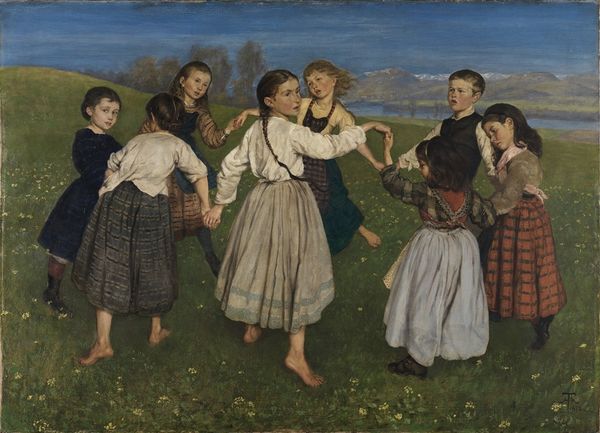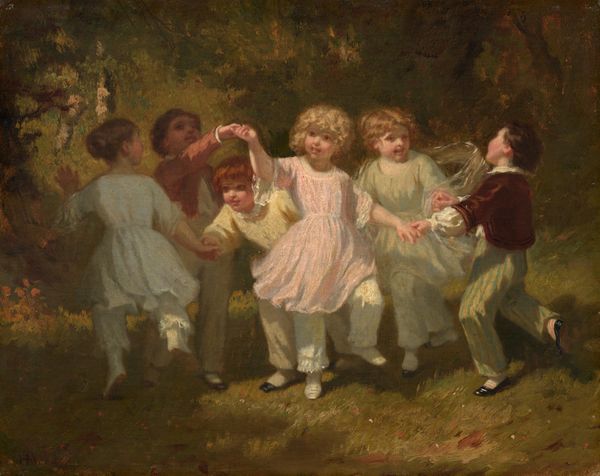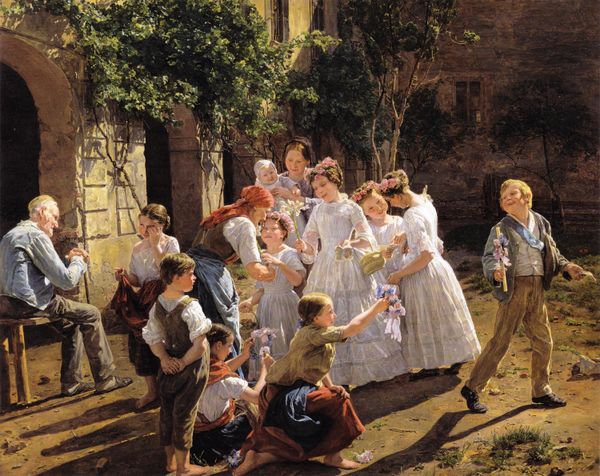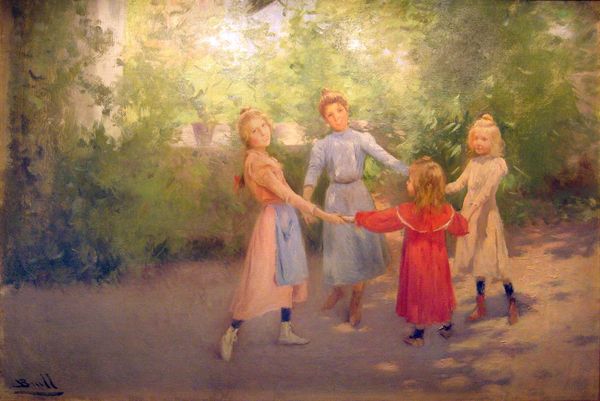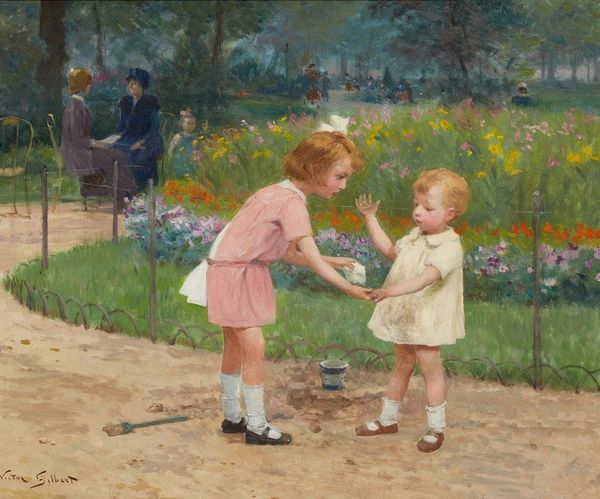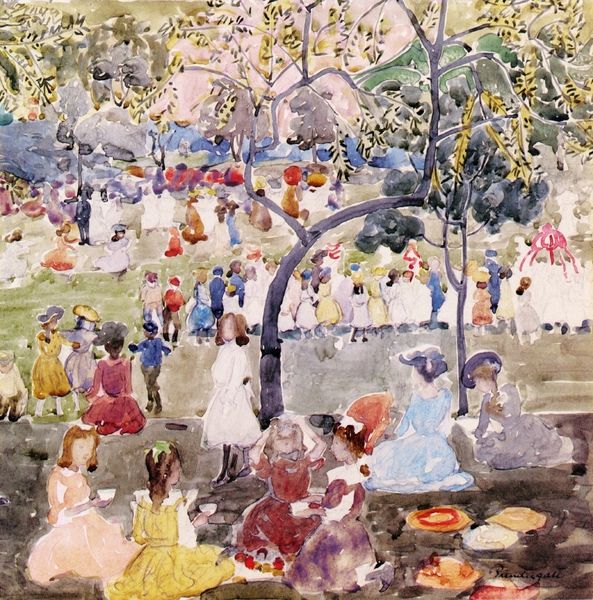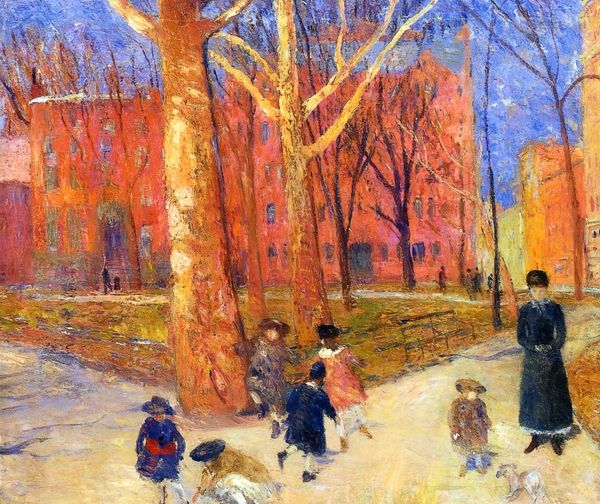
Dimensions: 109.5 cm (height) x 151.5 cm (width) (Netto)
Curator: Peter Hansen's "Playing Children, Enghave Square," painted around 1907 or 1908, offers us a glimpse into a past world. It is rendered in oil paint and presently resides here at the SMK. Editor: It feels immediately wistful, doesn’t it? A large canvas capturing a fleeting moment of girlhood, but it’s the quietude that strikes me. They're active, yes, but also contained. The palette seems deliberately muted. Curator: The subdued tones indeed carry symbolic weight. Consider the era; this was a time of rapid industrialization. Hansen seems to evoke a deliberate contrast between the energy of modern life and the innocent simplicity of childhood games. Editor: Absolutely, the contrast is clear, yet the image also feels fraught. Uniformed in these modest dresses, the girls almost resemble factory workers despite being out in a square. Curator: Interesting point. There's a collective identity emphasized through the repeated figures and forms. Circles of children mirrored by circular foliage above. It might point to the comforting and regulating nature of social structures. This square becomes a contained social microcosm. Editor: Agreed. Although the children are engaged in play, I'm wondering, too, about ideas of gender conformity at play, literally. They all present such neat and ordered images to each other, yet in their interactions might be reflecting an unacknowledged sense of obligation. What does community demand, particularly for women in that period? Curator: Certainly, the artist reveals both collective memory and an active tension between structure and play, which may have been the artist's intention when presenting this outdoor scene in Copenhagen's public square. He used these familiar scenes, genre-painting they are often called, to investigate human relations as much as Impressionist brushstrokes and rendering of light and shadow. Editor: Exactly, and as we stand here today, witnessing Hansen's quiet commentary on youthful conformity, it prompts us to reflect on the games we play, even now, in navigating social expectation. It makes one wonder about all the many roles imposed upon us. Curator: Indeed, considering the broader history of imagery connected to children and how the paintings and the iconographic depiction reflect on society reveals more of Hansen's vision for viewers both in his time and our own. Editor: Beautifully said, together it seems Hansen creates a resonant composition of color, movement, memory, and historical context, leaving me grateful for art’s reflective abilities.
Comments
statensmuseumforkunst almost 2 years ago
⋮
Girls come running, hand in hand, describing an undulating movement all through the painting. It is almost like a moment captured on film by a camera. The girls in the foreground and in the right-hand side of the painting have been cropped as if they are hurtled out of our angle of vision by their rapid, playful movement. The sunlight glistens in the girl's smock dresses, hair, and in the light green leaves. Peter Hansen had a predilection for depicting everyday scenes from his own neighbourhood. Here he showed children playing in the Enghave Plads square in the flickering sunlight. This is not an image of deprived, slaving working class children in a dingy backyard or in a factory; no, these children are engaged in light-filled games in their own neighbourhood - perhaps a delicate artistic prefiguring of the new opportunities available to the working class?
Join the conversation
Join millions of artists and users on Artera today and experience the ultimate creative platform.
statensmuseumforkunst almost 2 years ago
⋮
With a keen sense of social awareness, an unfettered grip on colour, and a vein of Impressionism that is firmly anchored in reality Peter Hansen depicts children playing outside his home on Enghavevej in Copenhagen.Hand in hand, a chain of little girls surge ahead, trying to catch their friends. The dynamic movement is accentuated by abrupt cropping and flickering reflections in the girl’s faces and the new-leaved trees. The painting's motifThe scene is from Copenhagen, specifically Enghave Plads on Vesterbro. From 1905 onwards, Peter Hansen kept his winter dwelling on Enghavevej, and he found most of his urban scenes in his neighbourhood. Without any indignation, but with keen interest in social issues he depicted modern life. He treated the idyllic aspects such as children playing and men enjoying a Sunday beer, but the vagabonds on Christianshavns Vold were also included in his image of the world.The artist's association FynboerneAs a student at Zahrtmann’s School during the years around 1890, Peter Hansen met two other artists from Funen: Johannes Larsen (1867-1961) and Fritz Syberg (1862-1939). Their friendship came to be at the heart of the artist’s association Fynboerne, but Peter Hansen’s most important sources of artistic inspiration were Kristian Zahrtmann (1843-1917) and Theodor Philipsen (1840-1920). Inspired by Kristian Zahrtmann and Theodor PhilipsenZahrtmann’s free treatment of colour and Philipsen’s mimetic Impressionism are continued in Hansen’s art. In Playing Children this legacy is apparent in the strong intensification of colour and the flickering reflections. Peter Hansen did not, however, become quite as anti-naturalistic in his colour treatment as Zahrtmann, nor did he dissolve his motifs in bursts of light and colour like Philipsen. Instead he retained his down-to-earth grip on reality as it is perceived.
statensmuseumforkunst almost 2 years ago
⋮
With his images of bathing boys, powerful ploughmen, and playing children Peter Hansen has created paintings that are easily inscribed into the Vitalistic art of the period. PLAYING CHILDREN in particular is no less ambitious than Willumsen’s A MOUNTAINEER. In this dynamic composition with its close croppings and flickering specks of light, an undulating chain of girls represent Hansen’s take on the hope for revival offered by the new century. In Willumsen, health, vitality, and youth became something visionary – here, they are treated rather closer to reality. The scene takes place in an area of Copenhagen where Hansen found most of his urban motifs. He depicted modern life with a commitment to social issues, and he had a keen eye for both the idyllic and for the injustices of life.
